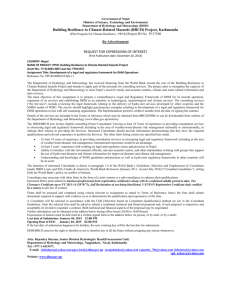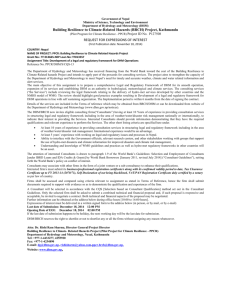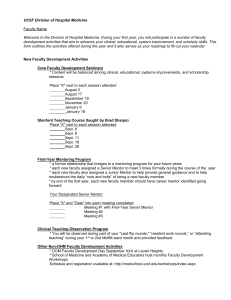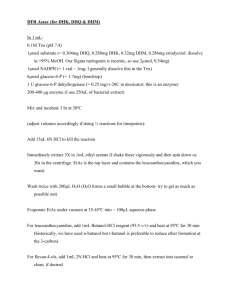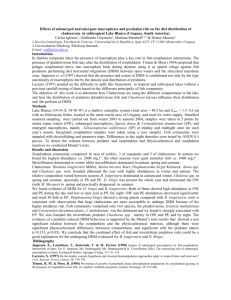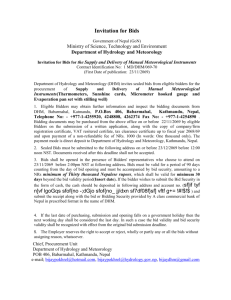Lecture 18 - Purdue University
advertisement
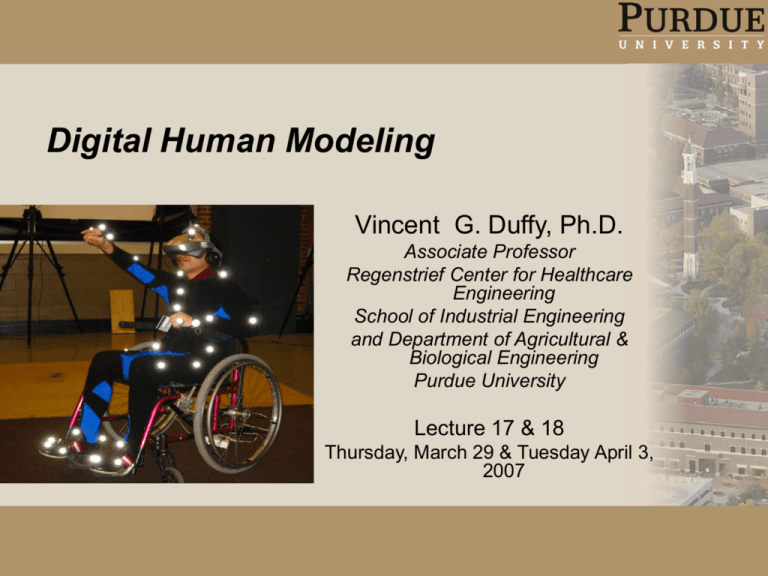
Digital Human Modeling Vincent G. Duffy, Ph.D. Associate Professor Regenstrief Center for Healthcare Engineering School of Industrial Engineering and Department of Agricultural & Biological Engineering Purdue University Lecture 17 & 18 Thursday, March 29 & Tuesday April 3, 2007 Overview Defining DHM Brief Research Background 1st Generation DHM: Empirically Driven Education & Original DHM Research Advanced 1st Generation DHM: Verification & Validation 2nd Generation DHM: Computationally Driven Moving Beyond Original Assumptions 3rd Generation DHM: Integrating the Cognitive Models Opportunities for DHM Research DHM in Healthcare Engineering Bringing the DHM Research Community Together Defining DHM Digital human models (DHM) – digital representation of the human inserted into a simulation or virtual environment to facilitate prediction of safety and/or performance – Includes a visualization and math/science in background Enables engineers – to incorporate ergonomics and human factors engineering principles earlier in the design process (Duffy, 2004; Chaffin, 2005) New concepts such as ‘Virtual Build’ using DHM – Eliminating need for prototyping – Facilitated by motion capture – See Brazier, et al. (2003), Li et al. (2004) at Applied Ergonomics, Wu et al. (2005) SAE-DHM – Providing real cost savings • $8.8 Million avoided in injury costs – Brazier, et al. (2003) Perception-based safety design I.3 Brief Research Background Leading to DHM Perception-based safety design applies fundamentals of human factors & ergonomics toward improved product and process design in various application domains including manufacturing, automotive, military and healthcare… through evaluations of the impact of perception & decisions on safety (Wickens, Lee, Liu & GordonBecker 2004) (Computers in Industry, 2003, Duffy, Wu & Ng) Originating with Computer-Aided Ergonomics & Safety (CAES) 1st Generation DHM: Empirically Driven Du, et al. (HAAMAHA 2005) used a NIOSH Lifting Equation, Static Strength Prediction - Postural Evaluation; Rapid upper limb assessment; Energy expenditure; Borg’s Rating of Perceived Exertion Chaffin,1999; NIOSH,1994; McAtamney, 1993; De Luca, 1997; Marras, 1990;Garg 1978; Borg, 1982 Courses, Students Students, Projects Education & Research IE 590D Applied Ergonomics – 30 students – many currently in industry registered through engineering professional education IE 656 Digital Human Modeling: Research Seminar - 12 Graduate & Undergraduate Students currently IE 486 Work Analysis & Design II – 80 students each semester Virtual Interactive Safety Design Advanced 1st Generation DHM: Verification & Validation New Real-time analysis; Motion capture; Old (Ch.1-upper left) (Ch.2-upper right) Virtual-view; (Ch.3-lower left) Real wheelchair (Ch.4-lower right) Virtual Interactive Safety Design Advanced 1st Generation DHM: Verification & Validation New Old Dynamic Aspects of Work Moving Beyond Original Assumptions Classification of risk using motion capture (Cappelli & Duffy, 2005; 2006) US Army-TACOM funded validation, dynamic aspects and cognitive model integration with Virtual Soldier Research (Mississippi State & U..Iowa) Virtual prototypes: limitations & challenges in simulation & validation 3rd Generation DHM: Integrating the Cognitive Models 60/749,553 provisional patent application & SAE 2006-01-1060 (Duffy, et al. 2005). Virtual prototypes: limitations & challenges in simulation & validation Trade-offs in virtual & real prototyping It was proposed that: When product or process requires more interactivity Full Prototype When product or process requires less interactivity Full Simulation Virtual environment for design iterations (Duffy, 2004) DHM: Opportunities for Research Origins: automotive, aerospace, military Current capabilities: engineering science, math & computing Needs: health systems, rehabilitation engineering Current limitations: cross-disciplinary research – – – – Needs driving emerging DHM Identify foundations, fundamentals Develop evaluation methods analysis tools & applications Engineering research: increased by more than $1B in the past four years (ASEE, 2005) Needs DHM Opportunities Capabilities Current Limitations Opportunities for DHM: Computational Modeling & Visualization Open loop vs. Closed loop -Closed loop- Device driven – eg. Biomedical Additional or Open effected by environment: human factors, HCI & ergonomics must be considered Data abounds in the health care industry and inexpensive sensors make more data easily accessible -Better methods are needed to effectively apply engineering principles to healthcare delivery (open loop) in a systematic way -Application of traditional OR techniques may not be sufficient due to inherent non-linearities that make models with simplifying assumptions difficult to validate Opportunities for DHM: Computational Modeling & Visualization Open loop vs. Closed loop -Closed loop- Device driven – eg. Biomedical Additional or Open effected by environment: human factors, HCI & ergonomics must be considered Data abounds in the health care industry and inexpensive sensors make more data easily accessible -Better methods are needed to effectively apply engineering principles to healthcare delivery (open loop) in a systematic way -Application of traditional OR techniques may not be sufficient due to inherent non-linearities that make models with simplifying assumptions difficult to validate Computing infrastructure initiatives at the national level may bring additional support for applying more computing intensive models. National attention has been brought to issues such as patient safety and the rising costs of healthcare that may encourage a willing partnership between engineering and the medical community for data gathering and model validation. Simulations & Training for Nurses: RCHE On-campus Visit DHM in Healthcare Engineering DNP & Research Staff in the Center for Nursing Education -Sim-Man -later to include Sim-Baby & Sim-Child using Health Fund Grant - Lifelike heart and lung sounds, arterial waveforms, pulses, and responds physiologically to treatment. - Can be programmed to cough, talk, moan, and respond to care while students monitor, analyze, and react. Simulations & Prescriptive Medicine DHM in Healthcare Engineering There is a need for applying related computational modeling methods to prescriptive medicine, according to recommendations from the National Academies Institute of Medicine's forthcoming report that was recently presented to the Scientific Advisory Committee on Infant Mortality. Simulations & Training for Surgeons Toward Minimally Invasive Tele-robot/Augmented Simulation Real Robotic Surgery Available - Laporoscopic Intuitive’s DaVinci – need training alternatives & lower cost solutions Bringing the DHM Research Community Together Supplementing SAE-DHM efforts through - ERCIM Digital Patient Working Group - 1st ICDHM at HCII 2007 - Handbook of Digital Human Modeling - 2nd AE 2008 - HFES HPM-TG Including Digital Visible Human ICPT- Visualization, Perceptualization & Data Rendering In Summary Occupational Ergonomics Applications for DHM Through DHM, various industries can bring occupational ergonomics earlier in design For addressing, particularly the science of work New DHM consider the changing nature of work Examples of interest internationally (eg. Digital Visible Human) Collaborating Centers and Academic Units at Purdue include: IE, RCHE, ABE, AMC, PLM, NEXTRANS, SoS, ICPT, ME, AAE, CE, Health Sciences, Envision Center, Center for Aging, Center for Nursing Education. with future applications especially in services industries such as: Healthcare, Energy, Logistics & Transportation Safety In Summary Occupational Ergonomics Applications for DHM Review questions: 1. A digital human model has which of the following: a. one part, and it is difficult to tell whether it is first, second or third generation b. two parts, including a visualization and some math and/or science in the background c. three parts, including a cognitive model d. my first Jack e. none of the above In Summary Occupational Ergonomics Applications for DHM Review questions: 1. A digital human model has which of the following: a. one part, and it is difficult to tell whether it is first, second or third generation b. two parts, including a visualization and some math and/or science in the background c. three parts, including a cognitive model d. my first Jack e. none of the above Answer: b In Summary Occupational Ergonomics Applications for DHM Review questions: 2. A cognitive model for DHM may be based on which of the following: a. Wickens Information Processing model b. A robot c. healthcare engineering d. all of the above e. none of the above In Summary Occupational Ergonomics Applications for DHM Review questions: 2. A cognitive model for DHM may be based on which of the following: a. Wickens Information Processing model b. A robot c. healthcare engineering d. all of the above e. none of the above Answer: a In Summary Occupational Ergonomics Applications for DHM Review questions: 3. Second generation models are: a. empirically driven b. computationally driven c. always focused on verification and validation d. all of the above e. none of the above In Summary Occupational Ergonomics Applications for DHM Review questions: 3. Second generation models are: a. empirically driven b. computationally driven c. always focused on verification and validation d. all of the above e. none of the above Answer: b In Summary Occupational Ergonomics Applications for DHM Review questions: 4. First generation DHM are: a. empirically driven b. more focused on validation and verification c. usually incorporate the physical aspects of work d. all of the above e. none of the above In Summary Occupational Ergonomics Applications for DHM Review questions: 4. First generation DHM are: a. empirically driven b. more focused on validation and verification c. usually incorporate the physical aspects of work d. all of the above e. none of the above Answer: d In Summary Occupational Ergonomics Applications for DHM Review questions: 5. Jack software: a. enables analysis of computer generated workstations b. is available to Purdue students through all ITaP labs, and at home c. includes analyses related to RULA, NIOSH Lift, Comfort, Snook Tables, Postural Analysis & Energy Expenditure d. all of the above e. none of the above In Summary Occupational Ergonomics Applications for DHM Review questions: 5. Jack software: a. enables analysis of computer generated workstations b. is available to Purdue students through all ITaP labs, and at home c. includes analyses related to RULA, NIOSH Lift, Comfort, Snook Tables, Postural Analysis & Energy Expenditure d. all of the above e. none of the above Answer: d In Summary Occupational Ergonomics Applications for DHM Review questions: 6. The human-system interface design for complex products can highlight a. current capabilities in cognitive models b. the need for more 1st generation models c. current limitations in DHM d. all of the above e. none of the above In Summary Occupational Ergonomics Applications for DHM Review questions: 6. The human-system interface design for complex products can highlight a. current capabilities in cognitive models b. the need for more 1st generation models c. current limitations in DHM d. all of the above e. none of the above Answer: c In Summary Occupational Ergonomics Applications for DHM Review questions: 7. Motion capture systems enable: a. new models without old assumptions b. integration with CAE c. data related to Velocities, Accelerations, Angular Velocities and Angular Accelerations d. all of the above e. none of the above In Summary Occupational Ergonomics Applications for DHM Review questions: 7. Motion capture systems enable: a. new models without old assumptions b. integration with CAE c. data related to Velocities, Accelerations, Angular Velocities & Angular Accelerations d. all of the above e. none of the above Answer: d
